To calibrate your sport watch altimeter, you’ll need either GPS data or a known elevation reference point. Outdoors, start an activity profile with clear sky visibility to enable GPS calibration, which automatically syncs your barometric readings with satellite elevation data. Indoors or when GPS signals are weak, access your watch’s altimeter settings through the menu and manually enter accurate elevation data from topographic maps or reliable online sources. Proper calibration reduces errors from ±20 feet to approximately 3 feet, making it essential before outdoor activities, weather changes, or temperature fluctuations. Understanding environmental factors and troubleshooting techniques will help you maintain consistently accurate readings throughout your adventures.
Understanding Barometric Altimeter Technology in Sport Watches
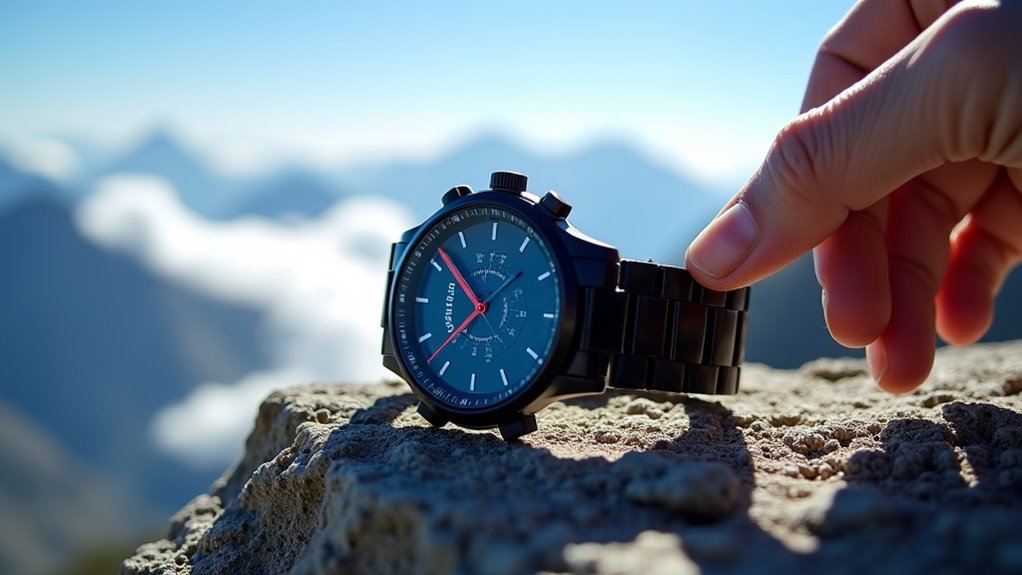
Precision matters when you’re scaling mountain peaks or traversing challenging terrain, and your sport watch’s barometric altimeter delivers that accuracy by measuring atmospheric pressure changes to calculate elevation.
Your watch’s barometer senses ambient air pressure, converting these readings into altitude data that’s displayed on your watch face in real-time.
However, you’ll need to establish a reference point for accurate readings. That’s where calibration becomes essential. Your altimeter requires either GPS data or manual entry to set this baseline, ensuring precise measurements throughout your activities.
Calibration sets the foundation for precise altimeter readings, requiring GPS data or manual baseline entry for accurate elevation tracking.
Weather sensitivity affects your altimeter’s performance since storms and pressure changes can impact accuracy. The watch features Auto mode that intelligently monitors pressure changes and switches between altimeter and barometer modes to maintain optimal performance.
When your watch combines barometric data with GPS, you’ll get enhanced precision while conserving battery life during non-exercise modes.
When and Why Altimeter Calibration Is Essential
Anyone who relies on their sport watch for accurate elevation data knows that calibration isn’t optional—it’s vital for safety and performance.
You’ll need to calibrate at the start of every outing, before weather changes, and after significant temperature fluctuations that affect barometric sensors. Without proper calibration, your readings can drift beyond 20 feet, creating dangerous navigation errors during critical decision-making moments.
Calibration dramatically improves accuracy by correcting pressure-related drift and aligning readings with real-world landmarks.
You’ll reduce error ranges from ±20 feet to approximately 3 feet under ideal conditions. This precision becomes most critical during high-altitude adventures, long-duration activities, and in areas with volatile weather patterns. For the most accurate initial readings, use Google Earth to establish your reference point before setting your altimeter.
Regular calibration guarantees your training data remains reliable and maintains your confidence in the device’s performance.
GPS-Based Automatic Calibration Methods
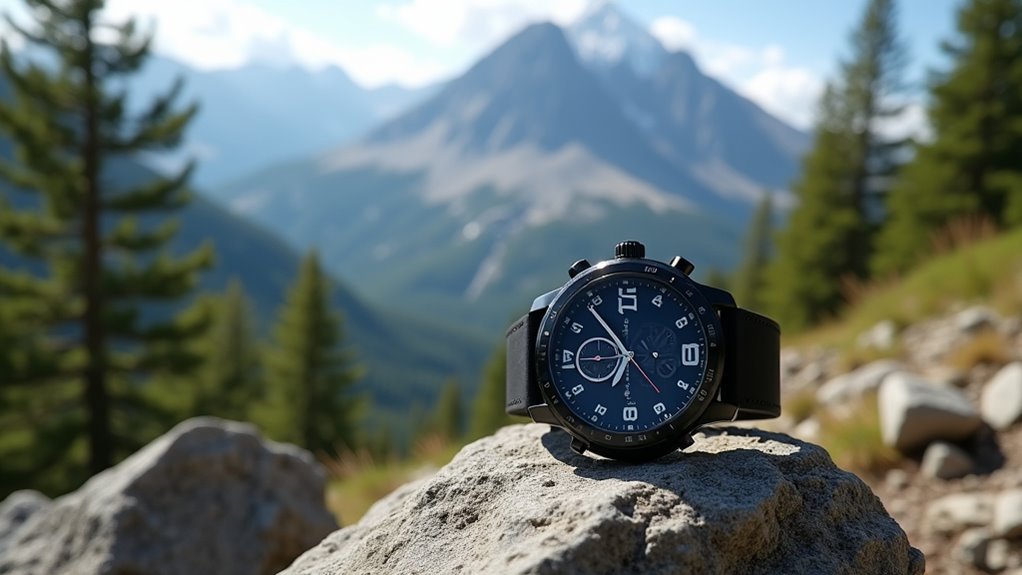
While manual calibration requires constant attention, GPS-based automatic calibration transforms your sport watch into a self-correcting elevation system that works behind the scenes.
Your device collects satellite data to determine elevation at your activity’s starting point, then compares this GPS reading against stored Digital Elevation Model data. The watch automatically syncs its barometric altimeter to match GPS elevation, eliminating constant manual adjustments.
GPS satellite data automatically calibrates your watch’s barometric altimeter by syncing elevation readings with Digital Elevation Model references.
You’ll find this feature reduces errors from weather changes and simplifies outdoor activities. However, GPS elevation accuracy can suffer under dense tree cover or among tall buildings. Weather affecting atmospheric pressure can cause errors even with automatic calibration systems.
Modern Garmin watches enable auto calibration through Sensors & Accessories > Altimeter > Auto Calibrate. For best results, start activities in open spaces and allow sufficient time for strong GPS signal acquisition.
Manual Calibration Techniques for Indoor Settings
When GPS signals aren’t available indoors, you’ll need to manually calibrate your sport watch altimeter using known elevation data.
Start by finding your current location’s accurate elevation through topographic maps, surveying benchmarks, or reliable online elevation services.
Once you’ve obtained the correct altitude value, enter it directly into your watch through the calibration menu to guarantee accurate readings. Navigate to the altimeter settings by holding the MENU button and selecting the manual calibration option for precise indoor adjustments.
Finding Accurate Elevation Data
Why does accurate elevation data matter so much for your sport watch calibration? It’s the foundation that makes your altimeter readings reliable and precise.
You’ll find several excellent sources for this critical data. Topographic maps provide detailed contours and elevation markings for specific locations. Digital Elevation Models (DEMs) offer precise digital elevation data through geographic information systems. Government websites maintain publicly accessible databases with accurate elevation information.
Your GPS device can provide elevation data, though accuracy varies with signal strength. For the most precise results, conduct local surveys or consult local authorities about specific areas.
When calibrating indoors, use these reference points to set your baseline. Many modern sport watches come with factory calibration already completed, which provides a solid starting point for your manual adjustments. Remember, your altimeter’s accuracy depends entirely on starting with correct elevation data from these trusted sources.
Entering Manual Altitude Values
Once you’ve gathered your reliable elevation data, you’ll need to input it directly into your sport watch through manual calibration.
Navigate to your watch’s main menu and access Sensors & Accessories settings to locate the Altimeter option. Select “Enter Manually” or equivalent manual calibration mode rather than automatic GPS-based calibration.
Hold the MENU button and follow your device’s interface to input the known elevation value in either meters or feet. Confirm your entry to adjust the barometric altimeter readings correctly.
This manual override compensates for weak GPS signals indoors and prevents errors from pressure changes unrelated to elevation.
Recalibrate frequently during indoor activities to maintain accuracy, as consistent manual calibration enhances data reliability in GPS-unavailable environments. Regular calibration is recommended for optimal performance and to ensure your altimeter continues providing accurate readings over time.
Step-by-Step Calibration for Garmin Sport Watches
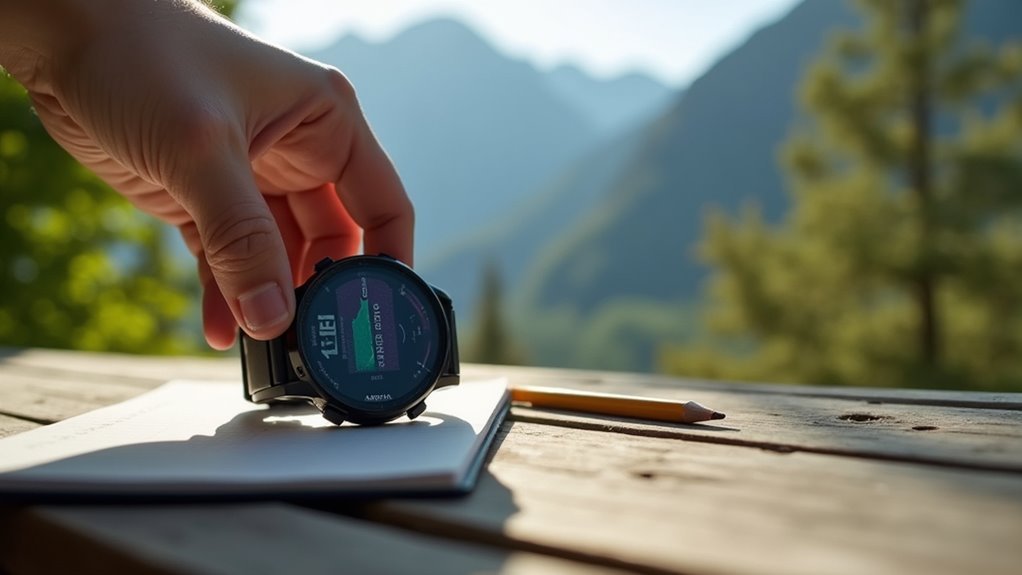
You’ll find two primary methods to calibrate your Garmin sport watch altimeter: GPS calibration and manual elevation input.
GPS calibration automatically uses satellite data to set your current elevation, while manual input lets you enter a known elevation value directly.
Both methods guarantee accurate altitude readings, but GPS calibration works best outdoors with clear sky visibility. Your watch comes factory calibrated and uses automatic calibration by default at the GPS starting point.
GPS Calibration Method
When your Garmin sport watch needs precise elevation readings for outdoor activities, GPS calibration offers the most convenient and reliable method to achieve accurate altimeter performance.
You’ll need to start an outdoor activity profile to guarantee strong GPS signal acquisition. Wait for your device to confirm GPS lock by displaying your location.
Press the MENU or UP button to access altimeter settings, then select “GPS” or “Auto Cal” as your calibration method. Your watch will automatically adjust elevation readings based on current GPS coordinates.
This method eliminates guesswork and provides consistent accuracy across various environments. For best results, perform calibration in open areas away from tall buildings or dense tree cover that might interfere with satellite signals. After GPS signal acquisition, wait an additional 30 seconds to allow the automatic calibration process to complete properly.
Manual Elevation Input
Manual calibration provides the most precise altimeter readings when you know the exact elevation of your current location. This method works across various Garmin models, including Forerunner and fēnix series watches.
To manually input elevation, hold the MENU button to access your watch’s settings. Navigate to the altimeter settings and select “Calibrate.” Choose “Enter Manually” from the calibration options, then input the known elevation data. Confirm your entry to complete the calibration process.
Manual input offers superior accuracy compared to DEM (Digital Elevation Model) systems, especially in areas where GPS signals are weak or DEM data is unreliable. This manual approach enhances accuracy for specific locations where precise elevation measurements are critical.
Verify you’re using accurate elevation data from reliable sources to avoid calibration errors that could affect your altimeter’s performance during activities.
Environmental Factors Affecting Altimeter Accuracy
While your sport watch altimeter provides valuable elevation data, several environmental factors can greatly impact its accuracy and require your attention during calibration.
Temperature variations affect air density and pressure, causing reading errors that you’ll need to account for. Higher humidity levels reduce air density, making your altimeter overestimate altitude readings.
Temperature and humidity changes directly impact your altimeter’s accuracy by altering air density and pressure readings.
Air pressure changes pose significant challenges since altimeters rely on standard atmospheric assumptions that rarely match real-world conditions.
At higher elevations, reduced air pressure and density create additional deviations in your readings.
Geographical features also matter—rough terrain, different surface materials like water or snow, and surrounding landscape elements can influence accuracy. Cold temperatures increase air density, which results in your altimeter displaying readings that are higher than actual altitude.
Your altimeter’s sensitivity to these conditions varies by design, so you’ll need to understand its specific limitations and follow manufacturer guidelines for peak performance.
Tools and Resources for Determining Current Elevation
Before calibrating your sport watch altimeter, you’ll need to establish an accurate baseline elevation using reliable reference tools and data sources. Several options are available to determine your current elevation with varying degrees of accuracy.
| Tool Type | Accuracy Level | Best Use Case |
|---|---|---|
| Total Stations | ±2mm per km | Professional surveying |
| Online Elevation Checkers | Variable | Quick reference checks |
| Barometers | Moderate | Weather-dependent readings |
| GPS Devices | ±3-5 meters | General outdoor use |
Online elevation checkers like WhatIsMyElevation.com provide convenient starting points, though professional surveying tools offer superior precision. Total stations achieve centimeter-level accuracy using reference points and slope distance measurements. For casual calibration, GPS devices and online resources typically provide sufficient accuracy for sport watch baseline establishment. Modern smartphones include built-in barometers that can serve as convenient elevation reference tools during the calibration process.
Troubleshooting Common Calibration Issues
Even with precise reference elevation data, your sport watch altimeter may display readings that seem off or behave unpredictably after calibration.
If you’re experiencing inaccurate or inconsistent readings, start by checking your reference position—an incorrect baseline can throw off all subsequent measurements. Environmental factors like temperature changes or atmospheric pressure shifts can also affect accuracy, so recalibrate when conditions change considerably.
When readings fluctuate wildly or automatic calibration fails, try a manual reset through your watch’s settings menu. Check if the sensor port on the right side of your watch is blocked by debris, as this can significantly impact barometric readings.
Update your device’s firmware if available, as software glitches often cause calibration problems.
If your altimeter continues showing erratic behavior or considerable discrepancies with known elevations, the barometric sensor may be damaged and require professional repair or warranty replacement.
Maintaining Long-Term Altimeter Performance
Once you’ve successfully calibrated your sport watch altimeter, consistent maintenance becomes essential for preserving accuracy over months and years of use.
Proper altimeter maintenance after calibration ensures your sport watch delivers reliable elevation readings for years of outdoor adventures.
You’ll need to perform regular battery checks and replacements to prevent power-related malfunctions. Inspect seals periodically and replace worn ones to maintain device integrity against moisture and debris.
Keep your software updated to enhance performance and fix bugs that could affect readings. Clean your watch regularly and store it properly to prevent damage from environmental factors.
Temperature changes, humidity, and pressure variations can impact accuracy, so you’ll want to recalibrate more frequently when conditions shift dramatically. Significant weather changes may require manual calibration to ensure your altimeter continues providing reliable elevation data.
Consider professional servicing at recommended intervals, typically every few years, to guarantee ideal long-term performance and catch potential issues early.
Frequently Asked Questions
How Often Should I Calibrate My Altimeter During Multi-Day Hiking Trips?
You should check and recalibrate your altimeter daily during multi-day hikes. Weather changes, barometric pressure shifts, and altitude variations can cause drift, so daily calibration guarantees you’ll maintain accurate readings throughout your trip.
Can Temperature Changes Affect My Altimeter Readings Between Calibrations?
Yes, temperature changes will affect your altimeter readings between calibrations. Cold conditions make your altimeter overestimate altitude, while hot conditions cause underestimation. You’ll notice bigger errors at higher elevations.
Will My Altimeter Work Accurately at Extremely High Altitudes Above 10,000 Feet?
Your altimeter can maintain accuracy within 50 feet up to 10,500 feet, but you’ll need frequent recalibration above that. Weather changes and pressure variations greatly affect readings at extreme altitudes.
Does Flying in an Airplane Require Recalibrating My Altimeter Afterward?
Yes, you’ll need to recalibrate your altimeter after flying. Airplane cabin pressure mimics 6,000-8,000 feet, causing drift in readings. Always manually recalibrate using a known reference point after disembarking.
Can I Calibrate My Altimeter Using Elevation Data From Smartphone Apps?
Yes, you can calibrate your altimeter using smartphone app elevation data. It’s practical when other references aren’t available, but it’s best for approximate adjustments since app data varies in precision and accuracy.
In Summary
You’ve learned the essential techniques for keeping your sport watch altimeter accurate and reliable. Whether you’re using GPS-based automatic calibration or manual methods, regular calibration guarantees precise elevation readings during your outdoor adventures. Remember to account for environmental factors like weather changes and temperature fluctuations. With proper maintenance and troubleshooting skills, you’ll maximize your altimeter’s performance and get the most accurate data for your training and exploration activities.

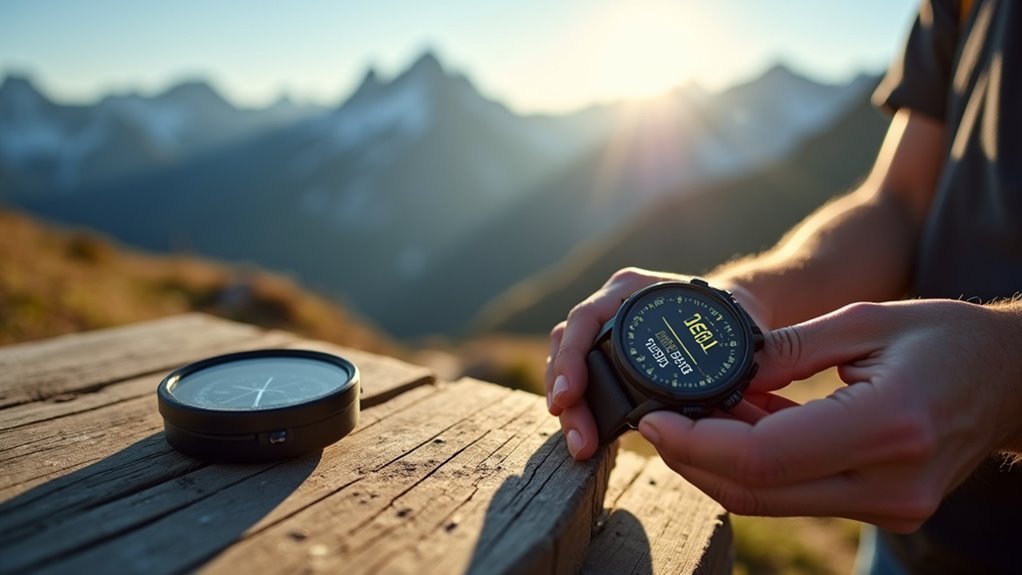
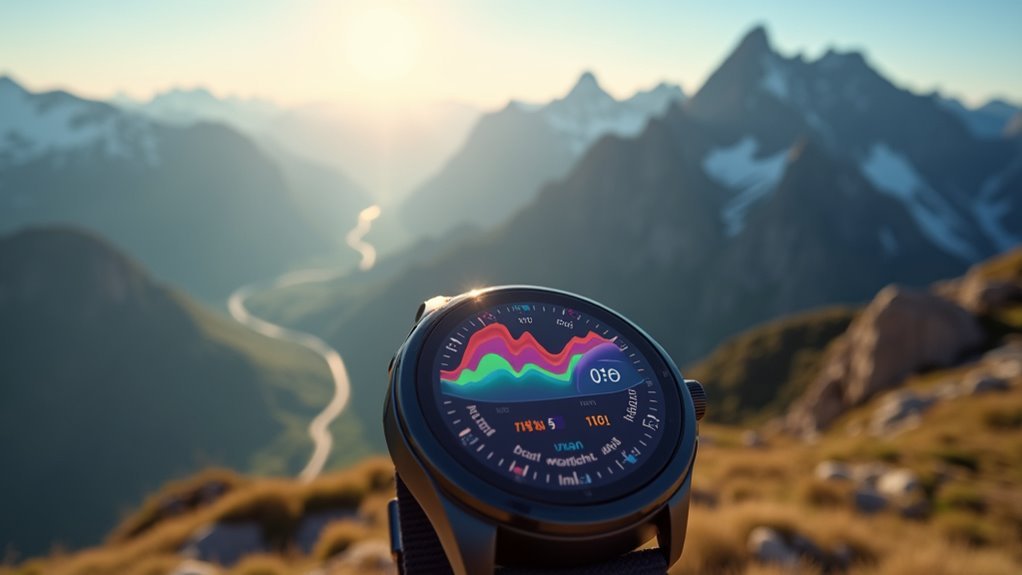
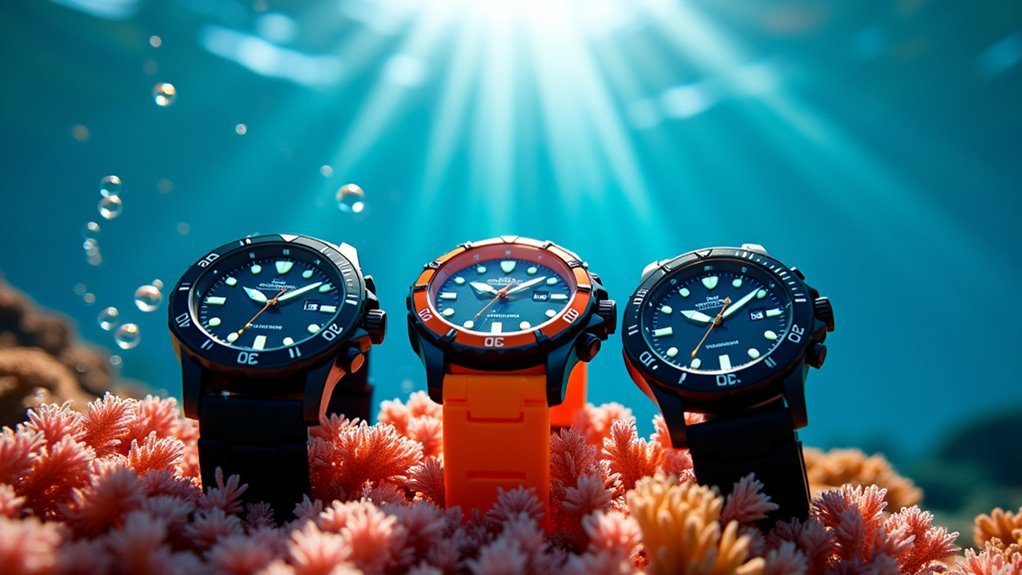
Leave a Reply